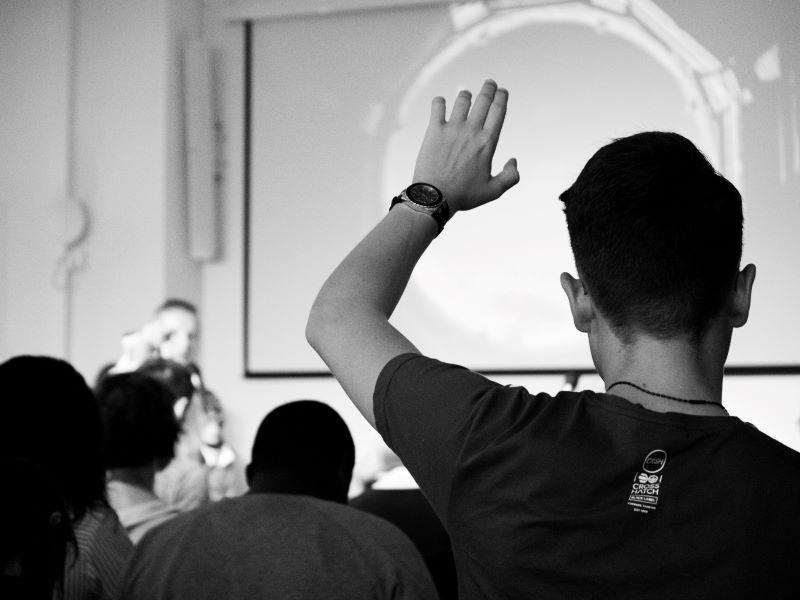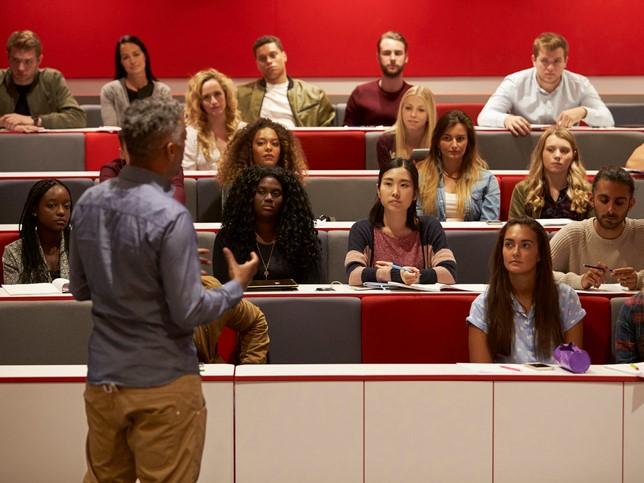Whatever one thinks about lectures, they’re here to stay. I just wish we better prepared people to give them. So here are a few things that I would like to say to a new lecturer.
I know I ought to ensure that they’re up to speed on constructive alignment and instructional scaffolding. But in truth, there are more human things that are far more important to get right, in particular when it comes to making people feel included.
So this piece doesn’t deal with any of the deeper, structural questions that we have to tackle in order to include. It’s about everyday, cost-free ideas for dealing with the diversity of minds and bodies that one encounters in a large lecture.
- Build your teaching presence to better engage students
- Say goodbye to classroom boredom
- Observe, improvise and listen: how to re-engage bored students
Say ‘hello’
Whenever possible, get to the lecture theatre ahead of time and tidy it up. Make it clear you are expecting people and that something important is going to happen there.
Check that the exits and stairwells are clear. Yep, it’s your responsibility. During the day people push things across access routes. And access needs vary considerably. Furthermore, if you ever find yourself teaching on the seventh floor of a large building that has just caught fire, you’ll realise that in that moment you really want everyone, whatever their egress needs might be, to get out quickly.
Then, when the students start to appear, stand by the door and say “hello” to those who come through it. Many of the students will be nervous about walking into such an impersonal space, especially at the start of their studies. A smile, plus a “hello” or a “good morning”, is a cost-free way of starting off on the right foot. Do this at every lecture you can, and you’ll be surprised what a positive twist it brings.
Encourage
Start the lecture by making it clear how pleased you are to see everyone. Every student sitting in front of you has made a conscious choice to come and listen to you talk. That’s one hell of a privilege you have there. Acknowledge that privilege in your attitude and behaviour.
What I’m really getting at here are the benefits of setting an encouraging tone from the start. That word “encourage” is so important. Some might say it’s the most important word in the lexicon of a teacher. If we can’t encourage learners, then we are surely lost.
What kind of encouragement can you give in a lecture? You can encourage students to attend the next one (lay down a teaser at the end). You can encourage them to concentrate on “the next 10 minutes – after which there’ll be a short break”. You can encourage them to choose to be interested in some of the things that you say.
Individuals, not cohorts
Your job, when lecturing, is not to talk to the “cohort” of students in the room. It’s to talk to every individual in the room. That’s not an easy thing to enact. To me it’s a “state of mind” thing rather than a “literally true” thing. I aim, as much as is humanly possible, to vary my focus across as many different individuals as possible as the sequence progresses.
Assume the best
By definition, everyone in the room is in attendance. But is everyone really there? Is everyone engaging fully? If you sit at the back of a lecture theatre observing a colleague, you will see that some proportion of laptop screens are displaying shopping portals and so forth. Aargh, so appalling! But before we continue in our outrage, hands up anyone who hasn’t answered an email with audio and video muted during an online meeting or checked the delivery notification that’s just come through. We are, you see, our students.
Looking from the front of the room, who among those tapping at their phone (plenty of students work on their phone) or at their keyboard are not engaging? Can you tell? Not really, to be honest.
So how about assuming the best of everyone. How about assuming that they are, in fact, all with you? Go on. I dare you. You’ll be somewhat wrong, but the longer you continue to assume that everyone is fully engaged, the less wrong you will become. It’s one of those self-fulfilling prophecy things.
Three-minute breaks
I’m not convinced by evidence that purports to say how long people can or cannot concentrate in a lecture. Those things are so topic-, context- and activity-dependent. I find it hard to focus for more than a few minutes when someone is reading from a script, unless they’re really good at it. But I could listen to Eddie Izzard talking for hours on end and I’d remember pretty much everything she said.
All that notwithstanding, I have found that it pays dividends to stop talking in roughly the middle of an hour-long lecture. You can give the students permission to check the notifications they’ve been sneaking a peak at during the first half of the session. The room erupts into noisy chatter. A very striking catharsis occurs.
And when three minutes are up, exhort the students to come “back into the room” with you: “Not long to go now, then it’s coffee time. Just do your best to focus for the next 20 minutes, please.”
Questions during the lecture?
Lectures aren’t the best place for students to ask questions. What’s on one person’s mind in a moment isn’t necessarily on several hundred other, diverse minds. Your job as the lecturer is to maintain a direction that maximises the chances of everyone being able to follow where you lead. Tell the students to email questions to you or wait until the lecture is over. If the question is of general relevance, it can be addressed during the next session.
Wave goodbye
Stand by the exit and say goodbye to the students in person. Many of them will wish you a good day. Many will also say “thank you”. These are nice words. We all need to hear them from time to time. After all, we all need encouragement.
Andy Grayson is associate professor in psychology at Nottingham Trent University. He has worked in higher education for more than 30 years and provides leadership on learning, teaching and assessment.
If you found this interesting and want advice and insight from academics and university staff delivered direct to your inbox each week, sign up for the THE Campus newsletter.




comment